by Martin Green
For a niche brand yet to celebrate its third birthday, Ferdinand Berthoud has made quite a horological impact: its Chronométrie Ferdinand Berthoud FB1 won the prestigious Aiguille d’Or at the 2016 Grand Prix d’Horlogerie de Genève. And now for 2018 the nascent brand presents a regulator: the Chronomètre FB 1R.6-1.
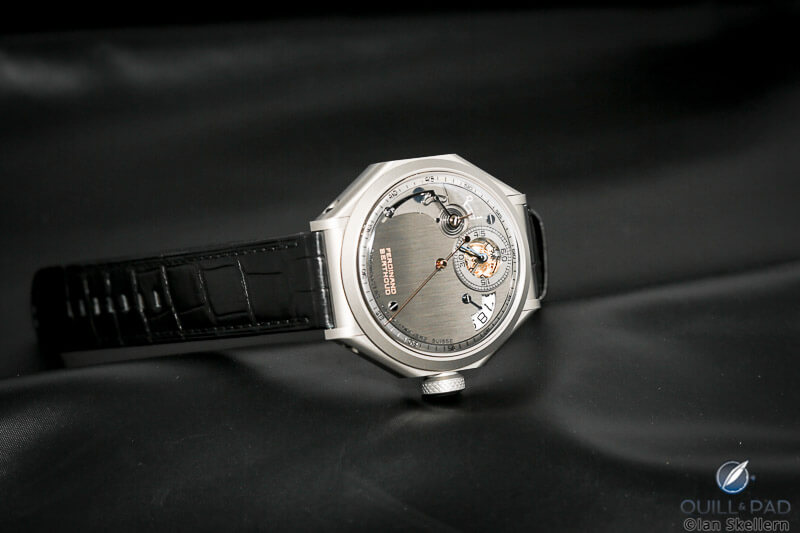
Ferdinand Berthoud Chronomètre FB 1R.6-1
Inspired by Marine Chronometer No.7, which was made by Ferdinand Berthoud himself more than 200 years ago, Chronomètre FB 1R.6-1 features an intriguing regulator configuration. I say intriguing because the way the different functions are positioned on the dial is far from common.
In fact, one might say that a few design rules have been broken in this unusual timepiece.
The top left part of the dial houses all the functions, leaving the bottom right as a “horological wasteland.”
Was this the act of a madman or is it the sign of a genius? I strongly argue for the latter.
This Ferdinand Berthoud model, or any of the others, are not sensible watches. Even in today’s world, a fusée-and-chain assembly is a horological tour de force but not a very sensible one. It takes up a tremendous amount of space while not outperforming today’s technology, which makes solutions that come in much more compact packages a much easier thing to master.
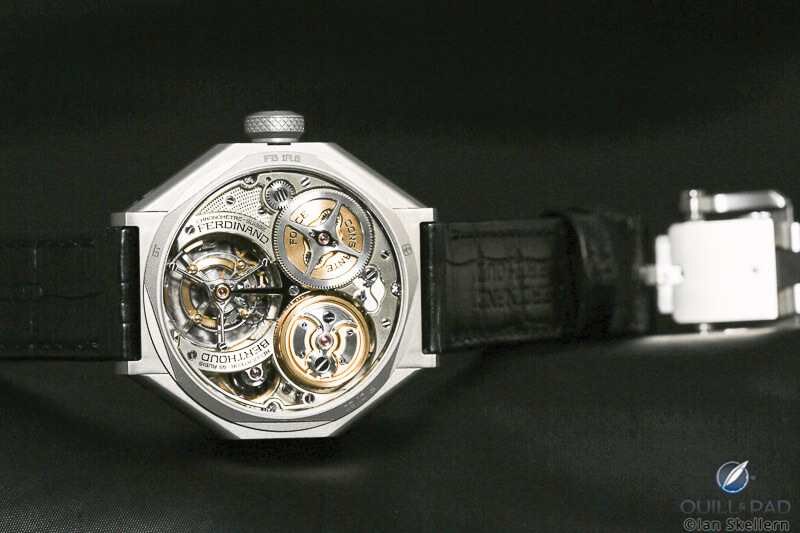
Back of the Ferdinand Berthoud Chronomètre FB 1R.6-1
That is also not the point, as these watches are in part also a tribute to the genius that was Ferdinand Berthoud. However, from the beginning, the modern Ferdinand Berthoud brand was not positioned as a classical tribute, but rather as an avant-garde interpretation of how a watch could have looked if Ferdinand Berthoud was still alive and active today.
Ferdinand Berthoud cares not for pleasing the masses
This makes room for creative freedom – and even more so since the production of Ferdinand Berthoud is strictly limited so there is no need to please the masses. The Chronomètre FB 1R.6-1 also doesn’t bother with this, its dial even covering the small glimpse of the tourbillon that the brand’s other models displayed.
I quite easily lost myself in the hand-crafted vertical satin brushing of the black rhodium-plated nickel silver dial and the likewise nickel silver plate and bridges of the movement.
It is the beauty of a desert: desolate yet not barren.
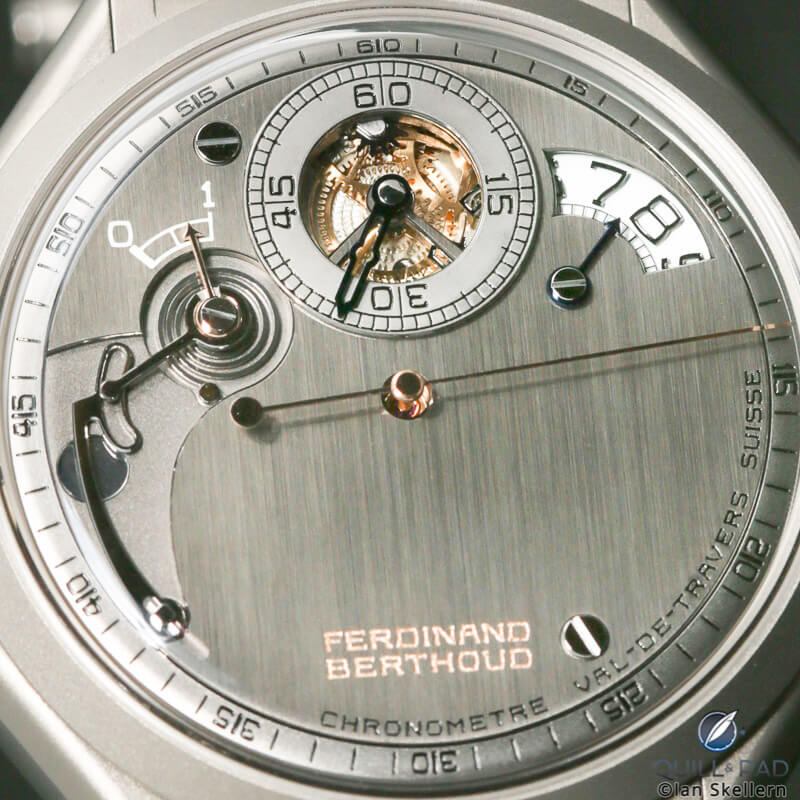
A close look at the dial side of the Ferdinand Berthoud Chronomètre FB 1R.6-1
The time indication then represents a thriving trade city on the edge of that desert, presenting its information in a dashboard kind of way, which makes it surprisingly easy to read.
Ferdinand Berthoud opened up the power reserve indicator, which gives the watch’s visuals the technical element that it was lacking as the dial on this model also covers the view to the movement inside.
The way the designers achieved this is in fact so novel that they have applied for a patent on it: a cone connected to the watch’s mainspring barrel is topped off with a feeler spindle. It passes on the energy state of the barrel to the levers on the dial indicating the power reserve. A spiral spring compensates for the play between the components inside the watch and increases the precision of the power reserve indicator.
The minute hand is pretty much the same as found on the boutique brand’s other models, yet its subdial is opened up in the middle to provide a view of the intriguing gear train connected to the hour indication on the right of it.
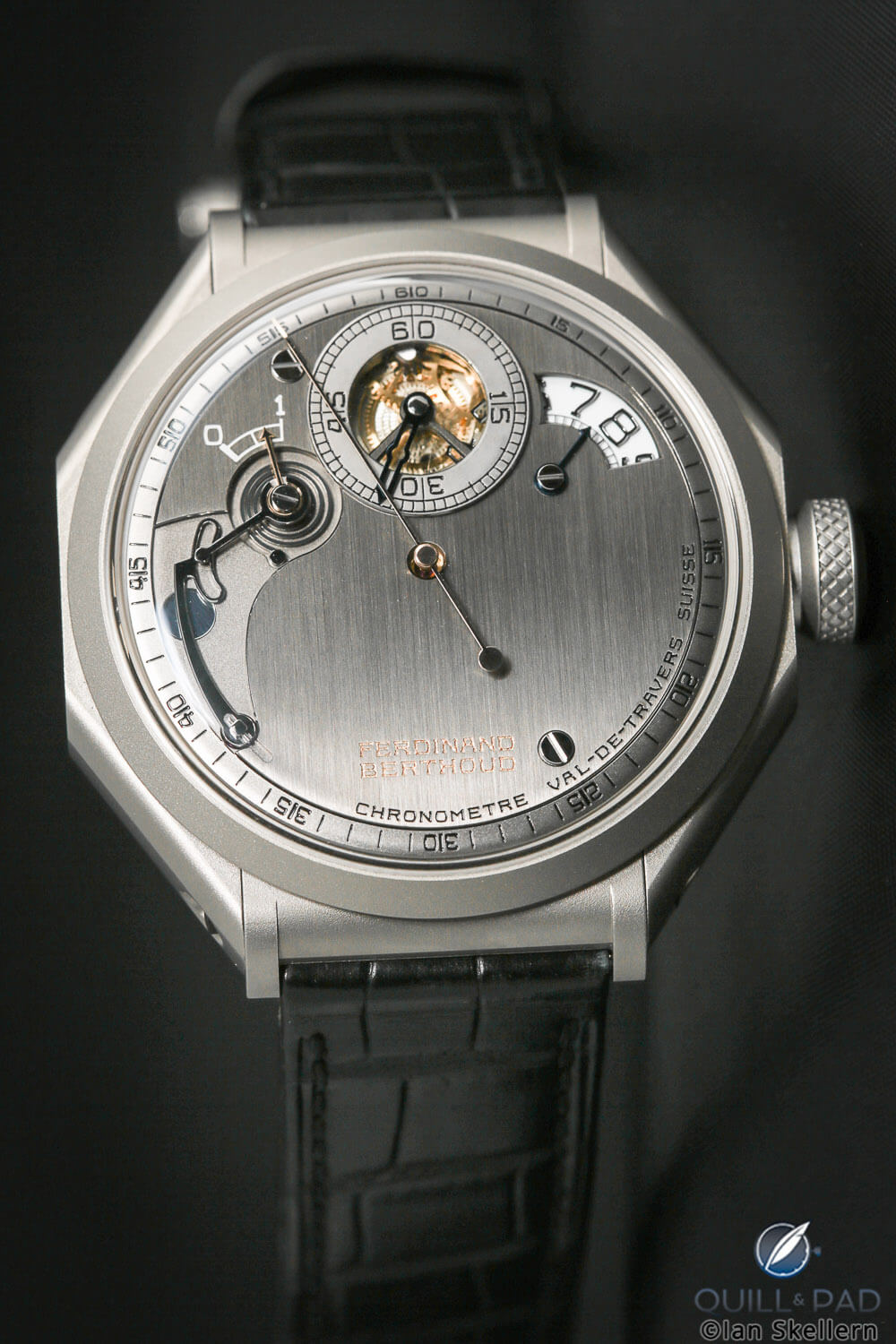
Ferdinand Berthoud Chronomètre FB 1R.6-1
These are trailing hours and not jumping hours, meaning that the disk moves slowly from one hour to another and doesn’t jump. This has several advantages: first and foremost the movement doesn’t have to build up power and release it all at once to make the jump of the hour happen.
That is quite a volatile process in a watch movement and can have a negative effect on its precision timekeeping capabilities.
Furthermore, an owner of the Chronomètre FB 1R.6-1 will probably get so used to this type of display over time that he or she doesn’t even need to check the minute hand to get a relatively accurate idea of what the time is.
How hard? Count the Vickers!
Another new element in the Chronomètre FB 1R.6-1 is the case. Like the Chronomètre FB 1.4-2, it is lacking portholes, but not all of them: there are windows inset into the left side of the case allowing visual appreciation of the fusée and chain.
More importantly, this model’s case is made from another material: steel!
An odd choice perhaps for a brand like Ferdinand Berthoud; but of course not just any steel was picked, but carburized steel. This is created by diffusing carbon particles into the steel substrate, merging the two materials with the result that it reaches a hardness of 1.200 Vickers.
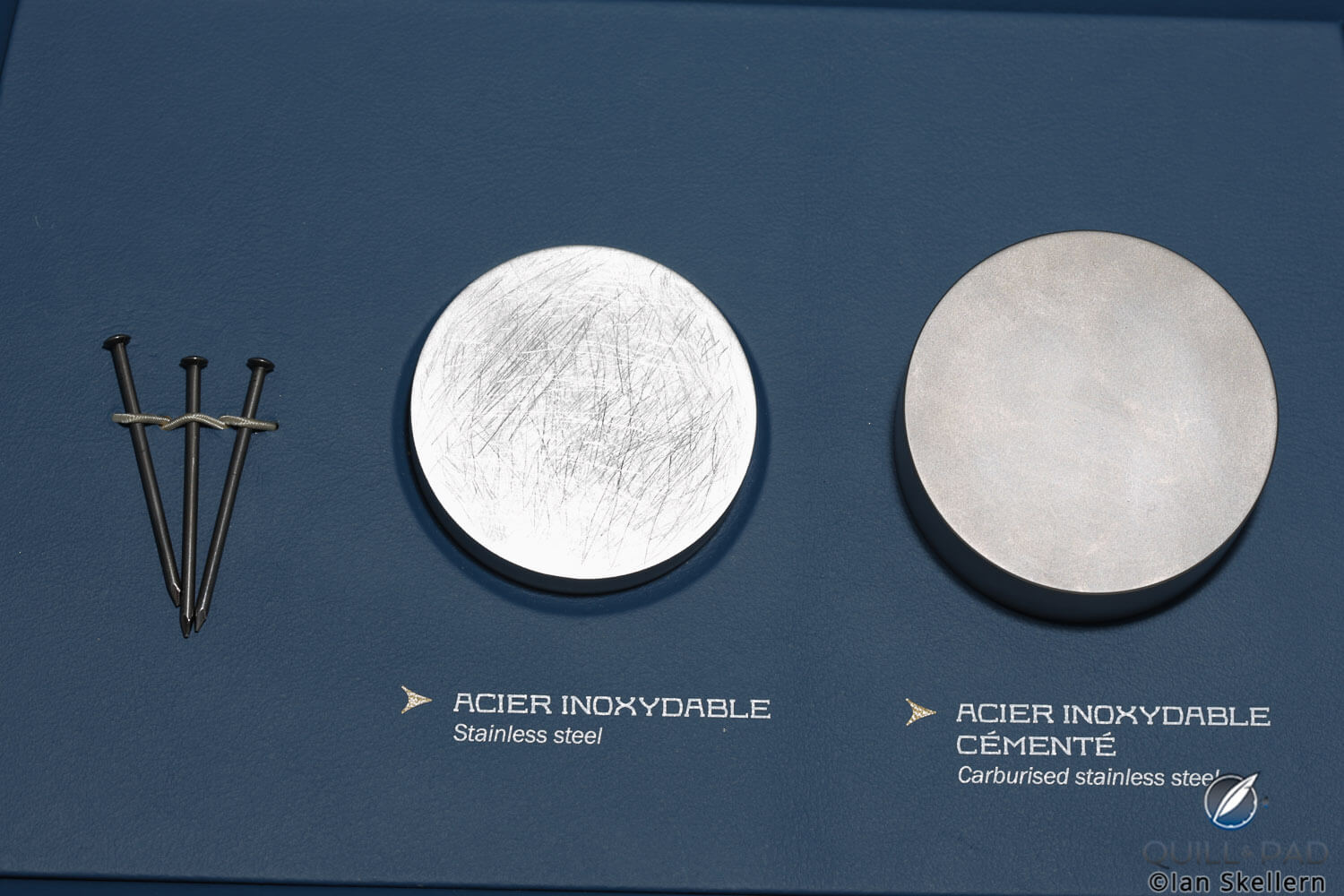
Scratch test: after days of SIHH scratching nails against these two disks of stainless steel and carburized stainless steel, the result is clear
This makes it incredibly hard to scratch, and actually makes you wonder if Ferdinand Berthoud is not slowly moving into ultra-high-end sports watch territory with the Chronomètre FB 1R.6-1.
While the movement is quite slim for the complications it houses and the way it is constructed, the watch is still 44 mm in diameter and 13.95 mm high, giving it quite a wrist presence. But with that carburized steel case you shouldn’t have have to worry too much about scratches.
Similar script, different cast
Although the movement features some modifications, including the reworked power reserve indicator and the regulator dial layout, it is still the same caliber. It would have been pointless for Ferdinand Berthoud to create a whole new movement for this watch, as it only makes a handful of watches each year, so there would be no justification for it. Also, the movement itself is so incredibly cool – so cool that you don’t want another caliber!
A chain-and-fusée constant force tourbillon is an exceedingly rare complication, even in today’s crowded haute horlogerie scene. And the way the entire movement is brought together using 18 nickel silver bridges surrounding the mechanical organs of the watch held up by titanium pillars is just remarkable. This layout is a nod to the construction of eighteenth-century marine chronometers, such as those that Ferdinand Berthoud built, yet highly complex to realize in a wristwatch.
Also, the finishing of the watch and its movement is second to none. That stainless steel chain in the chain-and-fusée assembly, which plays such an important role in the movement of the Chronomètre FB 1R.6-1, by itself consists of 790 components, all of which are individually hand-finished. That’s just the chain! That fact alone says something about the incredible eye for detail and craftsmanship that goes into creating the Chronomètre FB 1R.6-1.
Take your pick
While visiting the Ferdinand Berthoud booth at the 2018 SIHH, I was asked twice which model I preferred: the new regulator or the “older” style dial. Granted, I could live happily with both but did detect a small preference for the new Chronomètre FB 1R.6-1 within myself.
It is the unique dial layout of the FB 1R.6-1 that enticed my senses because it moved the watch even more away from mainstream watchmaking, despite being already quite a distance removed from it. That alone releases the watch even more from the laws of design, allowing it to exist in its own realm.
Probably not everybody shares my opinion in this, and that is actually okay as the Chronomètre FB 1R.6-1 is a watch that is not for everybody to like. And that by itself is quite tempting!
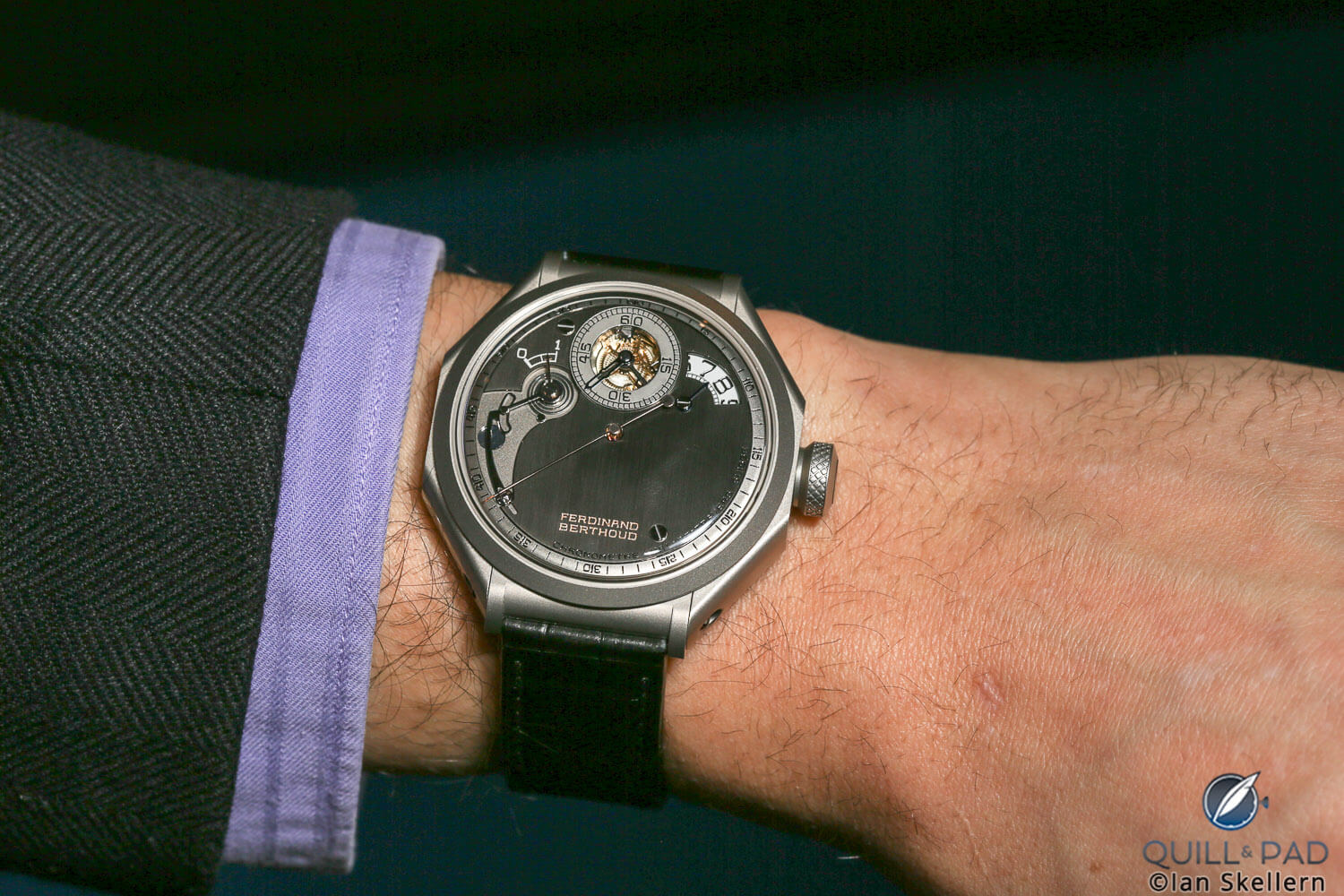
Ferdinand Berthoud Chronomètre FB 1R.6-1 on the wrist
For more information, please visit www.ferdinandberthoud.ch/en/collection/chronometre-fb-1r-6-1.
Quick Facts Ferdinand Berthoud Chronomètre FB 1R.6-1
Case: 44 x 13.95 mm, carburized steel
Movement: manufacture Caliber FB-T.FC.R, with chain-and-fusée one-minute tourbillon, power reserve 53 hours
Functions: hours, minutes, direct-drive second hand from tourbillon; power reserve indicator
Limitation: 20 pieces
Price: $241,500
You might also enjoy:
Ferdinand Berthoud Is Reborn With FB 1 Thanks To Chopard’s Karl-Friedrich Scheufele
Who Was Ferdinand Berthoud And Why Should We Care?
Chronomètre Ferdinand Berthoud FB 1, Winner Of The Aiguille d’Or At The 2016 Grand Prix d’Horlogerie de Genève
And you might find this video presenting the history of the brand interesting: https://www.youtube.com/watch?v=TsY6O0v8nTY.





















































Leave a Reply
Want to join the discussion?Feel free to contribute!